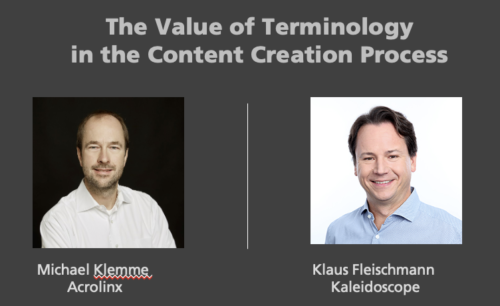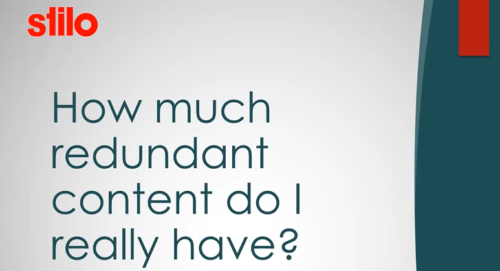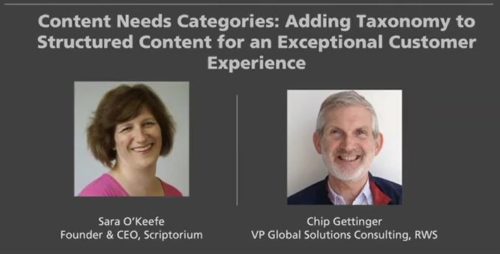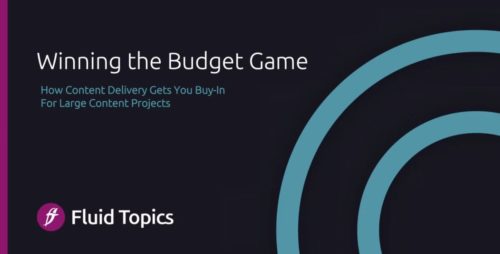Recorded:
April 13, 2022


Presented by Michael Klemme and
Klaus Fleischmann
Terminology is at the core of great content. When used consistently, it helps you communicate precisely and efficiently, which is an approach to your brand communication. It also makes your content accurate.
But it’s important to have a sound process in place to manage your terminology. Join us and learn how to:
-
Make sure all stakeholders have input into your terminology set
-
Set a process for consent and approval of your terms
-
Make sure you have a consistent and failsafe process to
-
Have all your terms for checking in Acrolinx, as the content quality solution of choice
-
Make sure all terminology action is concentrated in quickTerm, as the leading terminology system
Presented by:
Michael Klemme is a Senior Solutions Architect at Acrolinx. He advises new and existing customers on how they can efficiently integrate Acrolinx into their processes and helps partners to develop integrations.
Klaus Fleischmann studied translation and IT in Vienna, holds an MA in Conference Interpreting from Monterey, California, and a MAS in Technical Communication from Krems, Austria. In 1996, he founded Austria-based Kaleidoscope, a company implementing content, translation, and terminology management processes for internationally active companies. Kaleidoscope develops online collaboration software for enterprise-level terminology workflow, translator query management, in-country review etc., making the translation quality process comprehensible and strategically manageable. In 2007, he became CEO of Austria´s leading LSP, Eurocom Translation Services GmbH. Always active in the industry, Klaus got voted into the Gala Board of Directors in 2015 and 2017.
 The Future of Documents is shaped by a fundamental change in how information is exchanged. This future sees a shift from traditional 'e-paper', formatted and optimized for reading by humans, towards semantically tagged information - exchanged in an open digital format. In this talk, we will share examples from industries that have a history in structured content - such as publishing and technical documentation - as well as from industries that are ‘newer to the game’, such as pharma and financial services.
The Future of Documents is shaped by a fundamental change in how information is exchanged. This future sees a shift from traditional 'e-paper', formatted and optimized for reading by humans, towards semantically tagged information - exchanged in an open digital format. In this talk, we will share examples from industries that have a history in structured content - such as publishing and technical documentation - as well as from industries that are ‘newer to the game’, such as pharma and financial services.
 Jan Benedictus is Founder and Managing Director of Fonto. His experience goes back to the late 1990's when he started working in the field of online and digital publishing. In 2014, he started Fonto - with the mission to make structured content authoring available for everyone.
Fonto, now part of RWS, is the leading provider of user-friendly tools for structured content creation, editing and review. Jan is a regular speaker on the subject of The Future of Documents; sharing Fonto's experiences and insights from working with structured content in various industries.
Jan Benedictus is Founder and Managing Director of Fonto. His experience goes back to the late 1990's when he started working in the field of online and digital publishing. In 2014, he started Fonto - with the mission to make structured content authoring available for everyone.
Fonto, now part of RWS, is the leading provider of user-friendly tools for structured content creation, editing and review. Jan is a regular speaker on the subject of The Future of Documents; sharing Fonto's experiences and insights from working with structured content in various industries.

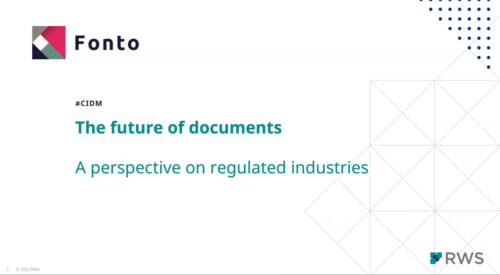
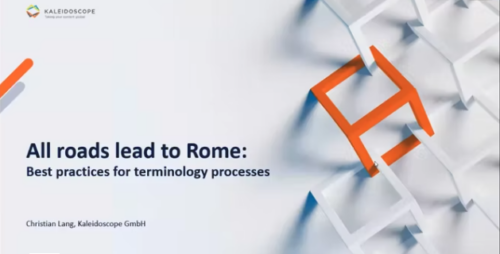

 Christian Lang, Technical Consultant, has a wide range of experience and interests in the language field, proven by his degree in Japanese studies and translation. He first became involved with terminology management as a freelance translator for the European Patent Office. Since then, it has become one of his hobbies, as has research in the field of NLP on topics such as machine translation, automatic term extraction, and concept maps.
Christian Lang, Technical Consultant, has a wide range of experience and interests in the language field, proven by his degree in Japanese studies and translation. He first became involved with terminology management as a freelance translator for the European Patent Office. Since then, it has become one of his hobbies, as has research in the field of NLP on topics such as machine translation, automatic term extraction, and concept maps.
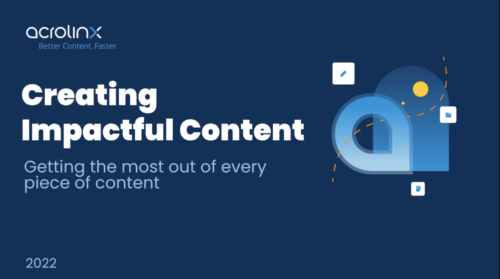
 Content fuels your business. It has a purpose and an expected outcome: Deeper engagement. Higher conversions. Fewer support tickets. The list goes on.
But does your content live up to its expectations? And if not, what can you do about it?
Join Chris Willis, Acrolinx CMO, as he explores the importance and value of content impact. You’ll learn:
Content fuels your business. It has a purpose and an expected outcome: Deeper engagement. Higher conversions. Fewer support tickets. The list goes on.
But does your content live up to its expectations? And if not, what can you do about it?
Join Chris Willis, Acrolinx CMO, as he explores the importance and value of content impact. You’ll learn:
 Christopher P Willis is Acrolinx’s Chief Marketing Officer, responsible for all aspects of the company’s Marketing strategy. Christopher is a specialist in Content Impact, AI, and pipeline management with over 20 years of experience growing companies in the technology sector. Before joining Acrolinx, Christopher held leadership roles in marketing, creative, technical, and business development at companies including Perfecto, Pyxis Mobile, KPMG-CT, ModelGolf, and Cambridge Technology Group. Willis is a recognized thought leader in the areas of AI, DEI and Content Impact, and is active within industry groups dedicated to the growth and health of Marketing Technology and the verticals he serves. Also, this year, Willis received a Top 100 Marketer Award in the 2022 OnCon Icon Awards.
Christopher P Willis is Acrolinx’s Chief Marketing Officer, responsible for all aspects of the company’s Marketing strategy. Christopher is a specialist in Content Impact, AI, and pipeline management with over 20 years of experience growing companies in the technology sector. Before joining Acrolinx, Christopher held leadership roles in marketing, creative, technical, and business development at companies including Perfecto, Pyxis Mobile, KPMG-CT, ModelGolf, and Cambridge Technology Group. Willis is a recognized thought leader in the areas of AI, DEI and Content Impact, and is active within industry groups dedicated to the growth and health of Marketing Technology and the verticals he serves. Also, this year, Willis received a Top 100 Marketer Award in the 2022 OnCon Icon Awards.
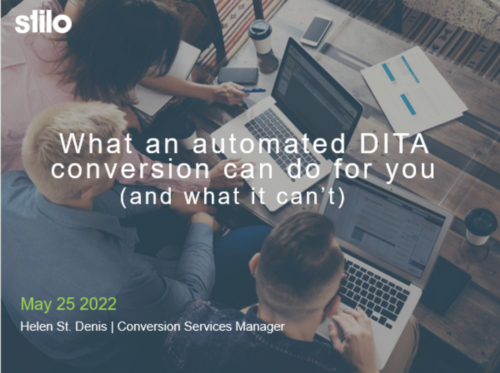

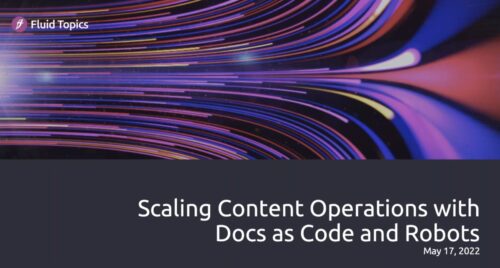
 While product cycles are getting shorter in all industries, down to daily releases for SaaS vendors, technical documentation teams have to keep up with the pace. Information needs to be written faster and delivered in sync.
Join Fabrice Lacroix, CEO and founder of Fluid Topics, and Gaspard Bébié-Valérian, certified technical writer and functional consultant, as they untangle the complex process of continuous content delivery and unveil new methods and processes to embrace the new landscape of documentation. They will share their insights and experience as they explore the collaborative potential between SMEs and tech writers opened by Docs as Code, examine the tooling behind a continuous documentation flow, and showcase the example of a robot writing release notes.
Presented by Fabrice Lacroix & Gaspard Bébié-Valérian:
Fabrice Lacroix is a serial entrepreneur and a technology pioneer. He has been working for 25 years on the development of innovative solutions around search technology, content enrichment and AI. He is the founder of Fluid Topics, the leading Content Delivery Platform that reinvents how users search, read and interact with technical documentation.
At the crossroads of engineering and social sciences, Gaspard enjoys exploring the breadth of technologies involved in technical documentation, including structured documentation, CCMS, and collaborative paradigms like docs as code. Gaspard works as Functional Consultant at Antidot helping clients get the most out of Fluid Topics.
While product cycles are getting shorter in all industries, down to daily releases for SaaS vendors, technical documentation teams have to keep up with the pace. Information needs to be written faster and delivered in sync.
Join Fabrice Lacroix, CEO and founder of Fluid Topics, and Gaspard Bébié-Valérian, certified technical writer and functional consultant, as they untangle the complex process of continuous content delivery and unveil new methods and processes to embrace the new landscape of documentation. They will share their insights and experience as they explore the collaborative potential between SMEs and tech writers opened by Docs as Code, examine the tooling behind a continuous documentation flow, and showcase the example of a robot writing release notes.
Presented by Fabrice Lacroix & Gaspard Bébié-Valérian:
Fabrice Lacroix is a serial entrepreneur and a technology pioneer. He has been working for 25 years on the development of innovative solutions around search technology, content enrichment and AI. He is the founder of Fluid Topics, the leading Content Delivery Platform that reinvents how users search, read and interact with technical documentation.
At the crossroads of engineering and social sciences, Gaspard enjoys exploring the breadth of technologies involved in technical documentation, including structured documentation, CCMS, and collaborative paradigms like docs as code. Gaspard works as Functional Consultant at Antidot helping clients get the most out of Fluid Topics. 


